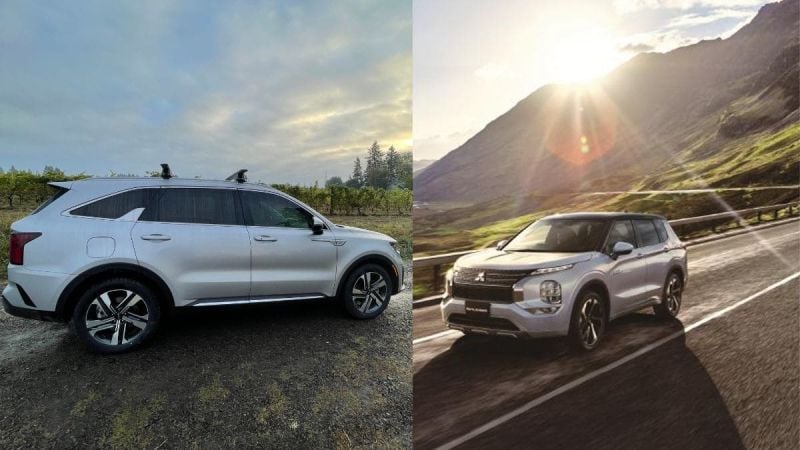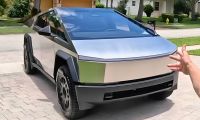You might ask, why is this guy doing this on paper? Technically the 2023 Mitsubishi Outlander PHEV hasn’t gone on sale in the U.S., yet. While I considered waiting for that to happen before making a purchase, once I was able to get specifications on the Mitsubishi it ultimately made my choice pretty easy.
Here’s how things worked out in a nutshell: I chose the Kia Sorento PHEV, which you would know if you’ve been reading my articles the last year or so, for a few reasons. First, it was available sooner (over one year sooner in fact). Second, it is larger and has more passenger and cargo capacity with a more usable third row (though neither is comfortable for taller adults on a longer drive). Third, it is a good deal more efficient, although the Mitsubishi Outlander PHEV does have greater all-electric range, which means as long as most of your driving is under 50 miles at a stretch, it could actually turn out to be more efficient in the long run. The Mitsubishi also has a few other advantages worth calling out: it costs less, has more torque, has one additional seat (because it has a middle bench, instead of captain’s chairs), has .4 inches more ground clearance, and the capability to fast charge on level 3/480V charging stations in around 40 mins to 80+% capacity.
Let’s look at the specs a little more closely. The Kia is almost 5 inches longer (189.4 vs. 184.8), almost 4 inches wider (74.8 vs. 70.9), but about half an inch shorter (66.7 vs. 67.3). While the Mitsubishi has seating for 7, vs. 6 for the Kia, the Kia has a good deal more interior volume in total (154.2 cubic ft. vs 137.2, or actually a bit less since this is for the regular ICE version of the Outlander). That breaks down to 143.7 vs. 125.5 cubic ft. in max passenger volume, or 75.5 vs 64.7 cubic ft. for max cargo volume, favoring the Kia in both cases. For anyone else that wishes the U.S. would just get over its obsessions with archaic units of measure, here’s those L x W x H and interior volume specs in the metric system for each. The Kia Sorento PHEV is 481 x 190 x 169 cm (rounded), and has 4366 liters interior volume vs. 3885 liters and 469 x 180 x 171 cm for the Mitsubishi.
When it comes to efficiency, the Kia has an EPA estimated 32 miles of range and 34 MPG combined when running in hybrid mode. As an owner of the Sorento PHEV for over a year, I will say that I am able to get over 40 miles on a full charge without trying too hard, (and even in winter can still get close to 40 miles on a full charge, depending) and can usually beat that 34 MPG combined rating, unless I am loaded down, have my snow tires on, or other obstacles to better fuel efficiency. I am sure the Mitsubishi is also capable of beating its 38 mile EV range if driven gently, but it gets a rather disappointing 26 MPG combined rating in hybrid mode. This was one of the main reasons I decided to pass on it. If I plugged the Mitsubishi’s capabilities into my driving stats for the last year, I would have driven about 10% more in EV mode than I did in my Kia, which seems great at first glance. But I drove a total of 2,890 miles on gas in my Kia with an estimated average of 35.8 MPG in the last year. If I “boosted” my estimated average MPG to 27.3 for the Outlander PHEV (5% better than EPA) and subtracted the additional 400 or so miles I would have driven in EV mode, I would have used about 91 gallons of gas, compared to only about 81 for my Kia. 10 extra gallons of fuel per year might not sound like much, but I’d rather not burn it if I don’t have to. The fact that the larger Sorento is more efficient really blows me away, and speaks to the quality of engineering Kia has put into its vehicle.
Everyone has their own priorities when it comes to making decisions on the purchase of a new car. Mine were guided more by the features in the case of these two vehicles and the larger, more useful interior and better combined fuel efficiency were particularly important to me. Which might you choose, and why? Please leave any comments or questions below.
Images courtesy of Justin Hart and Mitsubishi.
Justin Hart has owned and driven electric vehicles for over 14 years, including a first generation Nissan LEAF, second generation Chevy Volt, Tesla Model 3, an electric bicycle and most recently a Kia Sorento PHEV. He is also an avid SUP rider, poet, photographer and wine lover. He enjoys taking long EV and PHEV road trips to beautiful and serene places with the people he loves. Follow Justin on Twitter for daily KIA EV news coverage.













Comments
Great article What are your
Permalink
Great article What are your current thoughts now? I've read and watched a number of videos with real concerns about Turbo engines. Seems like a viable concern.
Turbo engines certainly have
Permalink
In reply to Great article What are your by Gabe Miller (not verified)
Turbo engines certainly have more opportunity to, or components that can, fail. Generally speaking, I would prefer to have a non aspirated engine as the hybrid power plant in my PHEV. That said, I’ve had zero issues with the 1.6L turbo in my Kia Sorento PHEV and it doesn’t have to work hard in hybrid mode unless I am really punching it to try and overtake on a steep hill or something like that. It is a smooth engine and I am impressed, for a vehicle of the Sorento’s size, that it works so well. The fact that the turbo usually doesn’t have to work that hard should help greatly in its longevity since heat is what kills turbos (well, and engine’s too) eventually. It would be interesting to me to know if Kia had left off the turbo and included a little more battery and more powerful electric motor, what the efficiency would be like. Worse, I suspect, but that’s just a guess. Otherwise, I would say this in response to your questions: both of these cars are worth looking at if you’re in the market for a PHEV SUV. They both have outstanding warranties (so that should help relieve some worry, at least), and the things that worry me (based on things I have read more than what I’ve experienced) are: Kia’s powertrain longevity (though I’ve read the 1.6L engine is one of their better/more reliable) and Mitsubishi’s battery longevity (previous generations had issues as I understand).
Thanks for the reply!
Permalink
In reply to Turbo engines certainly have by Justin Hart
Thanks for the reply! Consumer reports recently ranked the two. The Sorrento gets the overall better ranking but slightly less reliability compared to the Outlander.
Sounds about right to me, too
Permalink
In reply to Thanks for the reply! by Gabe (not verified)
Sounds about right to me, too. :) I hope my article and the info from CR helped you out. Please report back if you buy one or the other with your initial impressions!
Great article. For me, I
Permalink
Great article. For me, I prefer the 2023 Mitsubishi Outlander PHEV in a fully loaded SEL Premium trim because it's all of the above.
It is definitely an
Permalink
In reply to Great article. For me, I by Richard Joash Tan (not verified)
It is definitely an attractive PHEV option. I kind of feel like the Mitsubishi would have more capable AWD handling too. :)
Love to see Justin Hart and
Permalink
Love to see Justin Hart and John Goreham combine on a comparison since they come to somewhat different conclusions.
That’s a great idea! I’ll
Permalink
In reply to Love to see Justin Hart and by Burnside (not verified)
That’s a great idea! I’ll propose it to John. :) Thank you!
Can you please comment on the
Permalink
Can you please comment on the heat pump in the Outlander(apparently not availeble on the KIA). I live in cold climate, winter driving in below zero temperatures.
Hi John, I can’t comment on
Permalink
In reply to Can you please comment on the by John (not verified)
Hi John, I can’t comment on the Outlander’s heat pump specifically, but I can comment on heat pumps generally. They work great and are more efficient than resistive heaters. However, they are usually less effective in truly cold temperatures (which you described, since below zero temps would likely be a challenge for a heat pump). From reports I have read re: plug-in cars with heat pumps versus resistive heaters, versus vehicles like the Sorento which just use its gas engine for heat, I would say that whenever you get much below 15 degrees F, heat pumps are likely to struggle. Depending on how often your driving conditions are below zero, you may want to consider a plug-in vehicle that uses a resistive heater and or that uses a gas engine to supply heat (for example if temperatures are that cold for several weeks or even months out of they year). I hope that helps… and perhaps finding someone that owns a Mitsubishi Outlander PHEV and lives in a similar climate and ask them how well their heat pump works might validate even better.
I'd love to know more, hows…
Permalink
I'd love to know more, hows the car going still? How does it go towing?
The fact it has a spare wheel, and has a 6 speed gearbox where the petrol engine can perform more of the role on the longer trips seems quite attractive to me.
Any long term concerns? Can you see what battery degradation you have?